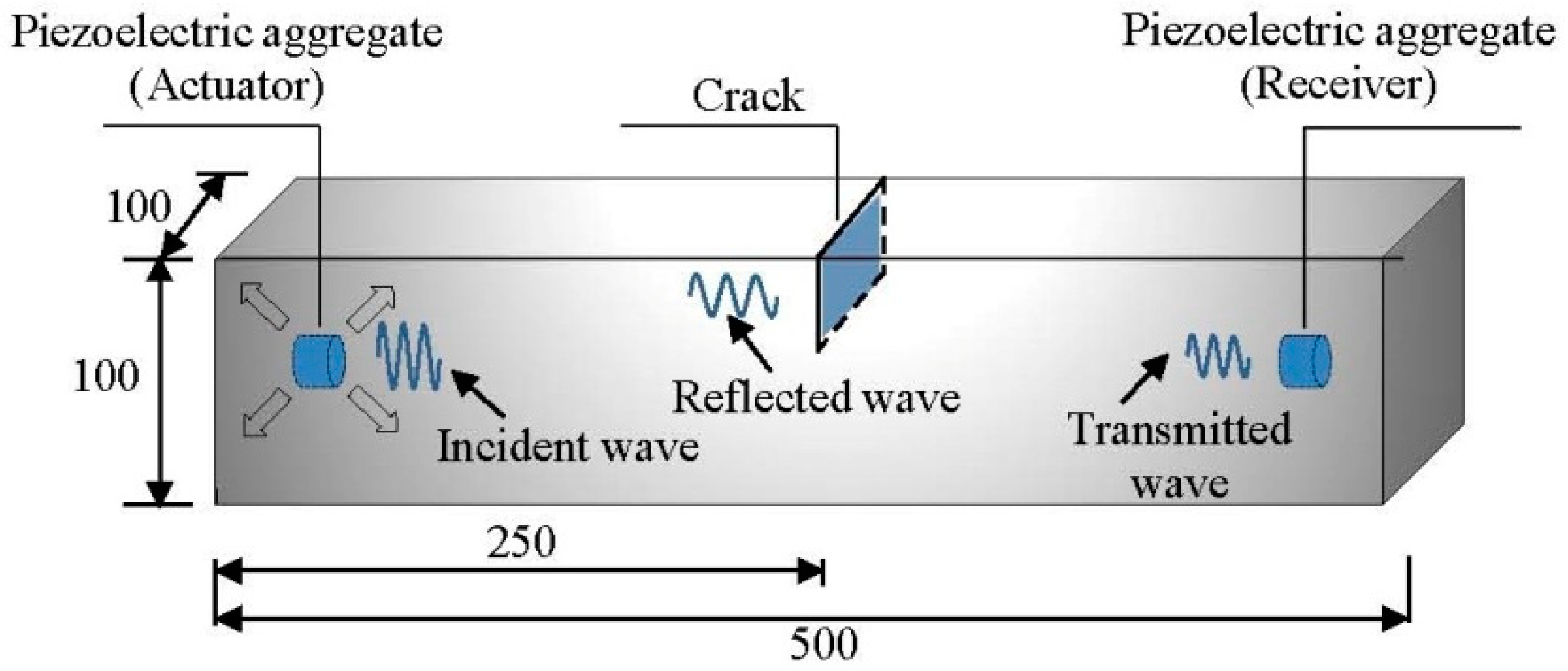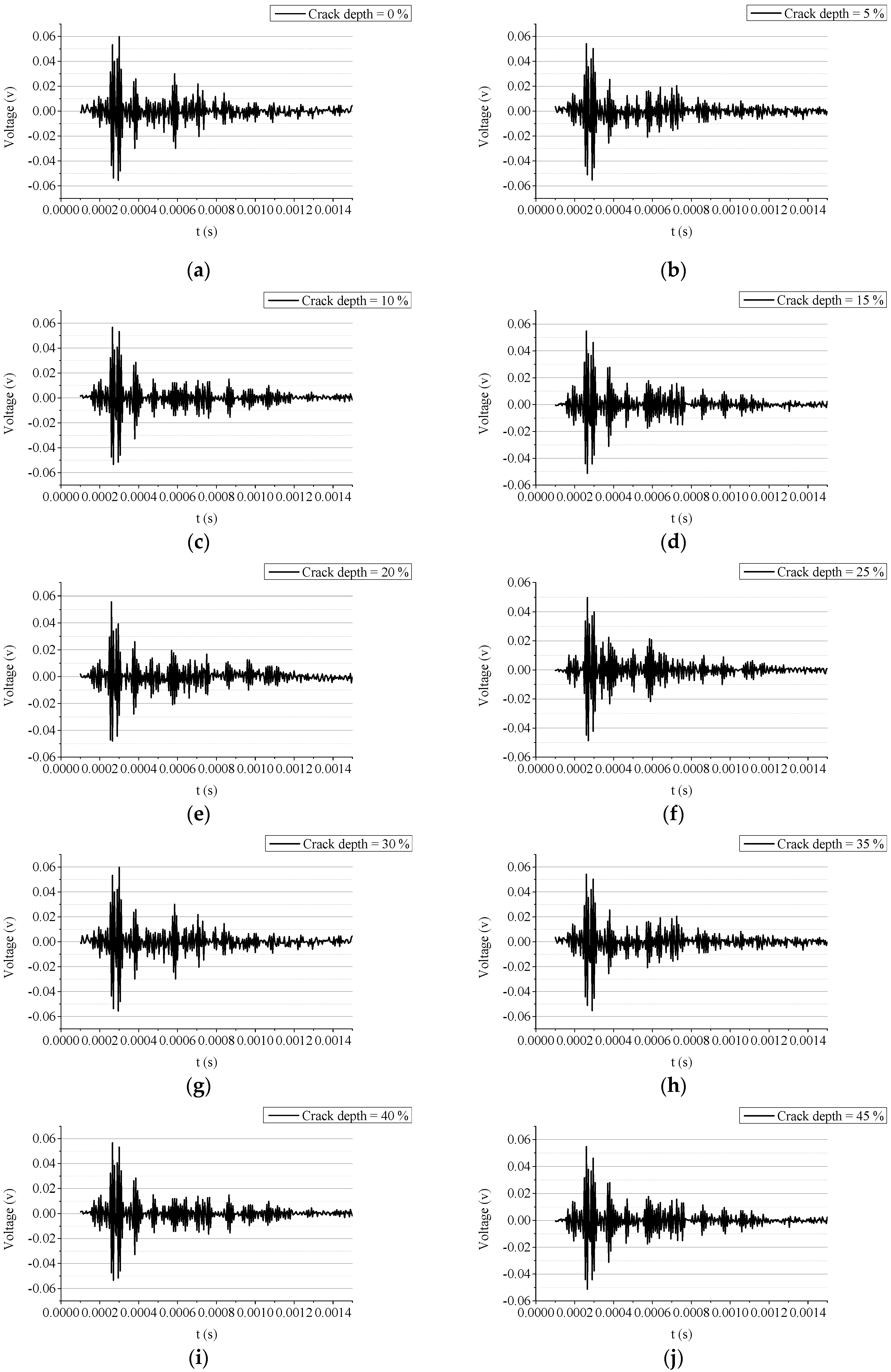Damage Quantification with Embedded Piezoelectric Aggregates Based on Wavelet Packet Energy Analysis
Abstract
:1. Introduction
2. Method of Damage Quantification
2.1. Elastic Waves in Cement Beams
2.2. The Wavelet Packet-Based Energy Analysis
3. Improved Piezoelectric Aggregate
3.1. Preparation of the TPA
3.2. Preparation of the IPA
3.3. Comparison between the IPA and the TPA
4. Numerical Investigation
4.1. Expilict Finite Element Analysis
4.2. Numerical Modelling
4.3. Damage Quantification Based on the Simulated Data
5. Experimental Investigation
5.1. Experimental Setup
5.2. Damage Quantification Based on the Measured Data
6. Conclusions and Path Forward
6.1. Conclusions
- The IPA sealed by the epoxy resin has better electric insulation than that of the TPA sealed by the cement. The new sealing process can effectively alleviate the cross talk in the acquired signal and facilitate the signal interpretation and damage quantification.
- The wavelet packet analysis is a reliable method to extract the elastic wave energy. The damage quantification index proposed in this paper is able to provide a linear characterization of the crack depth at the mid-span of the cement beam. According to the linear expression from the linear regression, the crack depth can be estimated by referring to the damage quantification index (WPEI).
- The embedment of the IPA can fulfill a global structural health monitoring for cement-based structures. Due to the good strength, high electric resistance, and compatible deformation, the IPAs can be built inside the structure and can characterize the structural state in real time.
6.2. Path Forward
- The piezoelectric aggregates require wires to provide power to excite the elastic waves, causing wiring issues. Self-powered or wireless powered piezoelectric aggregates can highly promote the application of the piezoelectric aggregates.
- The deformation of the piezoelectric aggregates can excite elastic waves in all directions. The diverging propagation of the elastic wave may cause energy loss and multiple reflections at the structural boundary, obstructing the interpretation of the acquired signals. A directional transducer, which can focus waves in a particular direction, is desirable to enhance the detection range.
Author Contributions
Funding
Conflicts of Interest
References
- Divsholi, B.S.; Yang, Y.W. Combined embedded and surface-bonded piezoelectric transducers for monitoring of concrete structures. NDT E Int. 2014, 65, 28–34. [Google Scholar] [CrossRef]
- Fan, W.; Qiao, P.Z. Vibration-based Damage Identification Methods: A Review and Comparative Study. Struct. Health Monit. 2011, 10, 83–111. [Google Scholar] [CrossRef]
- Chalioris, C.E.; Karayannis, C.G.; Angeli, G.M.; Papadopoulos, N.A.; Favvata, M.J.; Providakis, C.P. Applications of smart piezoelectric materials in a wireless admittance monitoring system (WiAMS) to Structures—Tests in RC elements. Case Stud. Constr. Mater. 2016, 5, 1–18. [Google Scholar] [CrossRef] [Green Version]
- Wang, W.T.; Lynch, J.P. IWSHM 2017: Application of guided wave methods to quantitatively assess healing in osseointegrated prostheses. Struct. Health Monit. 2018, 17, 1377–1392. [Google Scholar] [CrossRef]
- Wang, W.T.; Bao, Y.Q.; Zhou, W.S.; Li, H. Sparse representation for Lamb-wave-based damage detection using a dictionary algorithm. Ultrasonics 2018, 87, 48–58. [Google Scholar] [CrossRef]
- Mitra, M.; Gopalakrishnan, S. Guided wave based structural health monitoring: A review. Smart Mater. Struct. 2016, 25, 053001. [Google Scholar] [CrossRef]
- Song, G.; Gu, H.; Mo, Y.-L. Smart aggregates: Multi-functional sensors for concrete structures—A tutorial and a review. Smart Mater. Struct. 2008, 17, 033001. [Google Scholar] [CrossRef]
- Xu, B.; Zhang, T.; Song, G.B.; Gu, H.C. Active interface debonding detection of a concrete-filled steel tube with piezoelectric technologies using wavelet packet analysis. Mech. Syst. Signal Proc. 2013, 36, 7–17. [Google Scholar] [CrossRef]
- Kong, Q.Z.; Fan, S.L.; Bai, X.L.; Mo, Y.L.; Song, G.B. A novel embeddable spherical smart aggregate for structural health monitoring: Part I. Fabrication and electrical characterization. Smart Mater. Struct. 2017, 26, 8. [Google Scholar] [CrossRef]
- Kong, Q.Z.; Fan, S.L.; Mo, Y.L.; Song, G.B. A novel embeddable spherical smart aggregate for structural health monitoring: Part II. Numerical and experimental verifications. Smart Mater. Struct. 2017, 26, 9. [Google Scholar] [CrossRef]
- Wang, J.J.; Kong, Q.Z.; Shi, Z.F.; Song, G.B. A Theoretical Model for Designing the Novel Embeddable Spherical Smart Aggregate. IEEE Access 2018, 6, 48403–48417. [Google Scholar] [CrossRef]
- Yan, S.; Ma, H.Y.; Li, P.; Song, G.B.; Wu, J.X. Development and Application of a Structural Health Monitoring System Based on Wireless Smart Aggregates. Sensors 2017, 17, 1641. [Google Scholar] [CrossRef] [PubMed]
- Song, S.L.; Hou, Y.; Guo, M.; Wang, L.B.; Tong, X.L.; Wu, J.F. An investigation on the aggregate-shape embedded piezoelectric sensor for civil infrastructure health monitoring. Constr. Build. Mater. 2017, 131, 57–65. [Google Scholar] [CrossRef]
- Dumoulin, C.; Deraemaeker, A. Design optimization of embedded ultrasonic transducers for concrete structures assessment. Ultrasonics 2017, 79, 18–33. [Google Scholar] [CrossRef] [PubMed]
- Zou, D.J.; Liu, T.J.; Yang, A.T.; Zhao, Y.R.; Du, C.C. A primary study on the performance of piezoceramic based smart aggregate under various compressive stresses. Smart Mater. Struct. 2017, 26, 6. [Google Scholar] [CrossRef]
- Tian, Z.; Huo, L.S.; Gao, W.H.; Li, H.N.; Song, G.B. Modeling of the attenuation of stress waves in concrete based on the Rayleigh damping model using time-reversal and PZT transducers. Smart Mater. Struct. 2017, 26, 10. [Google Scholar] [CrossRef]
- Lim, Y.Y.; Kwong, K.Z.; Liew, W.Y.H.; Padilla, R.V.; Soh, C.K. Parametric study and modeling of PZT based wave propagation technique related to practical issues in monitoring of concrete curing. Constr. Build. Mater. 2018, 176, 519–530. [Google Scholar] [CrossRef]
- Ai, D.; Zhu, H.; Hui, L.; Chao, W. Mechanical impedance based embedded piezoelectric transducer for reinforced concrete structural impact damage detection: A comparative study. Constr. Build. Mater. 2018, 165, 472–483. [Google Scholar] [CrossRef]
- Gao, W.H.; Huo, L.S.; Li, H.N.; Song, G.B. An Embedded Tubular PZT Transducer Based Damage Imaging Method for Two-Dimensional Concrete Structures. IEEE Access 2018, 6, 30100–30109. [Google Scholar] [CrossRef]
- Zhang, J.; Li, Y.; Du, G.F.; Song, G.B. Damage Detection of L-Shaped Concrete Filled Steel Tube (L-CFST) Columns under Cyclic Loading Using Embedded Piezoceramic Transducers. Sensors 2018, 18, 2171. [Google Scholar] [CrossRef]
- Yan, S.; Dai, Y.; Zhao, P.T.; Liu, W.L. Interfacial damage identification of steel and concrete composite beams based on piezoceramic wave method. J. Appl. Biomater. Funct. Mater. 2018, 16, 70–80. [Google Scholar] [CrossRef] [PubMed]
- Markovic, N.; Nestorovic, T.; Stojic, D. Numerical modeling of damage detection in concrete beams using piezoelectric patches. Mech. Res. Commun. 2015, 64, 15–22. [Google Scholar] [CrossRef]
- Xu, B.; Chen, H.B.; Mo, Y.L.; Zhou, T.M. Dominance of debonding defect of CFST on PZT sensor response considering the meso-scale structure of concrete with multi-scale simulation. Mech. Syst. Signal Proc. 2018, 107, 515–528. [Google Scholar] [CrossRef]
- Chen, H.B.; Xu, B.; Mo, Y.L.; Zhou, T.M. Multi-Scale Stress Wave Simulation for Aggregates Segregation Detection of Concrete Core in Circular CFST Coupled with PZT Patches. Materials 2018, 11, 1223. [Google Scholar] [CrossRef] [PubMed]
- Feng, Q.; Cui, J.; Wang, Q.L.; Fan, S.L.; Kong, Q.Z. A feasibility study on real-time evaluation of concrete surface crack repairing using embedded piezoceramic transducers. Measurement 2018, 122, 591–596. [Google Scholar] [CrossRef]
- Wu, J.C.; Kong, Q.Z.; Lim, I.; Song, G.B. Feasibility Study of Interlayer Slide Monitoring Using Postembedded Piezoceramic Smart Aggregates. J. Sens. 2018. [Google Scholar] [CrossRef]
- Hou, S.; Kong, Z.H.; Wu, B.; Liu, L. Compactness Monitoring of Compound Concrete Filled with Demolished Concrete Lumps Using PZT-Based Smart Aggregates. J. Aerosp. Eng. 2018, 31, 9. [Google Scholar] [CrossRef]
- Zhang, H.B.; Hou, S.; Ou, J.P. Feasibility of SA-based concrete seismic stress monitoring for high-strength concrete. J. Intell. Mater. Syst. Struct. 2017, 28, 2428–2436. [Google Scholar] [CrossRef]
- Markovic, N.; Nestorovic, T.; Stojic, D.; Marjanovic, M.; Stojkovic, N. Hybrid approach for two dimensional damage localization using piezoelectric smart aggregates. Mech. Res. Commun. 2017, 85, 69–75. [Google Scholar] [CrossRef]
- Liu, T.J.; Zou, D.J.; Du, C.C.; Wang, Y. Influence of axial loads on the health monitoring of concrete structures using embedded piezoelectric transducers. Struct. Health Monit. 2017, 16, 202–214. [Google Scholar] [CrossRef]
- Dumoulin, C.; Deraemaeker, A. Real-time fast ultrasonic monitoring of concrete cracking using embedded piezoelectric transducers. Smart Mater. Struct. 2017, 26, 9. [Google Scholar] [CrossRef]
- Karayannis, C.G.; Voutetaki, M.E.; Chalioris, C.E.; Providakis, C.P.; Angeli, G.M. Detection of flexural damage stages for RC beams using Piezoelectric sensors (PZT). Smart. Struct. Syst. 2015, 15, 997–1018. [Google Scholar] [CrossRef]
- Voutetaki, M.E.; Papadopoulos, N.A.; Angeli, G.M.; Providakis, C.P. Investigation of a new experimental method for damage assessment of RC beams failing in shear using piezoelectric transducers. Eng. Struct. 2016, 114, 226–240. [Google Scholar] [CrossRef]
- Jiang, T.Y.; Kong, Q.Z.; Peng, Z.; Wang, L.; Dai, L.Z.; Feng, Q.; Huo, L.S.; Song, G.B. Monitoring of Corrosion-Induced Degradation in Prestressed Concrete Structure Using Embedded Piezoceramic-Based Transducers. IEEE Sens. J. 2017, 17, 5823–5830. [Google Scholar] [CrossRef]
- Du, C.C.; Zou, D.J.; Liu, T.J.; Lv, H.X. An exploratory experimental and 3D numerical investigation on the effect of porosity on wave propagation in cement paste. Measurement 2018, 122, 611–619. [Google Scholar] [CrossRef]
- Xu, K.; Kong, Q.Z.; Chen, S.; Song, G.B. Early Determination of the Presence of Low Strength Concrete in Reinforced Concrete Beam-Column Joints Using Piezoceramic-Based Transducers. IEEE Sens. J. 2017, 17, 3244–3250. [Google Scholar] [CrossRef]



















| w/c Ratio | Curing Period | Curing Temperature | Curing Moisture |
| 0.36 | 28 days | 20 ± 2 °C | 97 ± 2% |
| Density | Poisson Ratio | Elastic Modulus | Electric Resistance |
| 2350 kg/m3 | 0.2 | 3.25 × 1010 Pa | 6.00 × 109 Ω·m |
| Size (mm) | TPA | IPA | Piezoelectric Ceramic |
|---|---|---|---|
| Inner diameter | 20 | 20 | 14 |
| Height | 20 | 20 | 1 |
| Density | Poisson Ratio | Elastic Modulus | Electric Resistance |
|---|---|---|---|
| 1200 kg/m3 | 0.38 | 2.00 × 109 Pa | 1.60 × 1014 Ω·m |
| Residual Sum of Squares | Adjusted R-Square | Intercept (Standard Error) | Slope (Standard Error) |
|---|---|---|---|
| 1.6693 × 10−18 | 0.9522 | 1.0124 × 10−8 (2.2186 × 10−10) | −1.0142 × 10−10 (6.8333 × 10−12) |
| Residual Sum of Squares | Adjusted R-Square | Intercept (Standard Error) | Slope (Standard Error) |
|---|---|---|---|
| 9.3882 × 10−4 | 0.9733 | 0.4529 (0.0053) | −0.0033 (1.6205 × 10−4) |
© 2019 by the authors. Licensee MDPI, Basel, Switzerland. This article is an open access article distributed under the terms and conditions of the Creative Commons Attribution (CC BY) license (http://creativecommons.org/licenses/by/4.0/).
Share and Cite
Wang, Z.; Wei, L.; Cao, M. Damage Quantification with Embedded Piezoelectric Aggregates Based on Wavelet Packet Energy Analysis. Sensors 2019, 19, 425. https://doi.org/10.3390/s19020425
Wang Z, Wei L, Cao M. Damage Quantification with Embedded Piezoelectric Aggregates Based on Wavelet Packet Energy Analysis. Sensors. 2019; 19(2):425. https://doi.org/10.3390/s19020425
Chicago/Turabian StyleWang, Zijian, Li Wei, and Maosen Cao. 2019. "Damage Quantification with Embedded Piezoelectric Aggregates Based on Wavelet Packet Energy Analysis" Sensors 19, no. 2: 425. https://doi.org/10.3390/s19020425
APA StyleWang, Z., Wei, L., & Cao, M. (2019). Damage Quantification with Embedded Piezoelectric Aggregates Based on Wavelet Packet Energy Analysis. Sensors, 19(2), 425. https://doi.org/10.3390/s19020425






